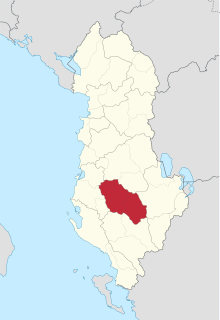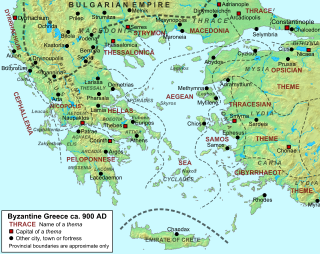The history of Albania forms a part of the history of Europe. During classical antiquity, Albania was home to several Illyrian tribes such as the Ardiaei, Albanoi, Amantini, Enchele, Taulantii and many others, but also Thracian and Greek tribes, as well as several Greek colonies established on the Illyrian coast. In the 3rd century BC, the area was annexed by Rome and became part of the Roman provinces of Dalmatia, Macedonia and Moesia Superior. Afterwards, the territory remained under Roman and Byzantine control until the Slavic migrations of the 7th century. It was integrated into the Bulgarian Empire in the 9th century.

Epirus is a geographical and historical region in southeastern Europe, now shared between Greece and Albania. It lies between the Pindus Mountains and the Ionian Sea, stretching from the Bay of Vlorë and the Acroceraunian Mountains in the north to the Ambracian Gulf and the ruined Roman city of Nicopolis in the south. It is currently divided between the region of Epirus in northwestern Greece and the counties of Gjirokastër, Vlorë, and Berat in southern Albania. The largest city in Epirus is Ioannina, seat of the region of Epirus, with Gjirokastër the largest city in the Albanian part of Epirus.

When the Roman Empire divided into east and west in 395, the territories of modern Albania became part of the Byzantine Empire. At the end of the 12th century, the Principality of Arbanon was formed which lasted until mid 13th century, after its dissolution it was followed with the creation of the Albanian Kingdom after an alliance between the Albanian noblemen and Angevin dynasty. After a war against the Byzantine empire led the kingdom occasionally decrease in size until the Angevins eventually lost their rule in Albania and led the territory ruled by several different Albanian chieftains until the mid 14th century which for a short period of time were conquered by the short-lived empire of Serbia. After its fall in 1355 several chieftains regained their rule and significantly expanded until the arrival of the Ottomans after the Battle of Savra.
This is a timeline of Albanian history, comprising important legal and territorial changes and political events in Albania and its predecessor states. To read about the background to these events, see History of Albania. See also the list of Albanian monarchs and list of heads of state of Albania.

Berat County, officially the County of Berat, is a county in the Southern Region of the Republic of Albania. It is the ninth largest by area and the ninth most populous of the twelve counties, with around 119,450 people within an area of 1,798 km2 (694 sq mi). The county borders the counties of Elbasan to the north, Korçë to the east, Gjirokastër to the south and Fier to the west. It is divided into five municipalities, Berat, Dimal, Kuçovë, Poliçan and Skrapar, with all of whom incorporate twenty-five administrative units.

The history of Byzantine Greece mainly coincides with the history of the Empire itself.

The Despotate of Epirus was one of the Greek successor states of the Byzantine Empire established in the aftermath of the Fourth Crusade in 1204 by a branch of the Angelos dynasty. It claimed to be the legitimate successor of the Byzantine Empire, along with the Empire of Nicaea and the Empire of Trebizond, its rulers briefly proclaiming themselves as Emperors in 1227–1242. The term "Despotate of Epirus" is, like "Byzantine Empire" itself, a modern historiographic convention and not a name in use at the time.

Ivan Asen I, also known as Asen I or John Asen I was emperor of Bulgaria from 1187 or 1188 to 1196 as the co-ruler with his elder brother, Peter II. He was the son of a wealthy shepherd from the mountains of the Byzantine theme (district) of Paristrion. All contemporaneous chronicles describe Asen I and his brothers as Vlachs.
Peter II, born Theodor, also known as Theodor-Peter was the first emperor of the restored Bulgarian Empire from 1185 to 1197. He was the son of a wealthy shepherd from the mountains of the Byzantine theme of Paristrion. He and his younger brothers, Asen and Kaloyan, were mentioned as Vlachs in most primary sources, but they were most probably of mixed Vlach, Bulgarian and Cuman origin.
The term Albanian principalities refers to a number of principalities created in the Middle Ages in Albania and the surrounding regions in the western Balkans that were ruled by Albanian nobility. The 12th century marked the first Albanian principality, the Principality of Arbanon. It was later, however, in the 14th century and the beginning of the 15th century that these principalities became stronger, especially with the fall of the Serbian Empire. Some of these principalities were notably united in 1444 under the military alliance called League of Lezhë.

Arbanon was a principality ruled by the native Progoni family, and the first Albanian state to emerge in recorded history. The principality was established in 1190 by the native archon Progon in the region surrounding Kruja, to the east and northeast of Venetian territories. Progon was succeeded by his sons Gjin and then Demetrius (Dhimitër), who managed to retain a considerable degree of autonomy from the Byzantine Empire. In 1204, Arbanon attained full, though temporary, political independence, taking advantage of the weakening of Constantinople following its pillage during the Fourth Crusade. However, Arbanon lost its large autonomy ca. 1216, when the ruler of Epirus, Michael I Komnenos Doukas, started an invasion northward into Albania and Macedonia, taking Kruja and ending the independence of the principality. From this year, after the death of Demetrius, the last ruler of the Progon family, Arbanon was successively controlled by the Despotate of Epirus, then by the Bulgarian Empire and, from 1235, by the Empire of Nicaea.
After the weakening of the Byzantine Empire and the Bulgarian Empire in the middle and late 13th century, the northern territory of modern day Albania became part of Serbia. Firstly, as part of Serbian Grand Principality and later as part of Serbian Empire. The southern part was governed by the semi-independent, Serbian-ruled Despotate of Epirus. Between 1272 and 1368, some areas of the modern-day state were also ruled by the Angevins as the Kingdom of Albania. In the late 14th century, Albanian Principalities were created throughout Albania.
The Principality of Valona & Kanina, also known as the Despotate of Valona & Kanina or simply the Principality of Valona (1346–1417) was a medieval principality in Albania, roughly encompassing the territories of the modern counties of Vlorë (Valona), Fier, and Berat. Initially a vassal of the Serbian Empire, it became an independent lordship after 1355, although de facto under Venetian influence, and remained as such until it was conquered by the Ottoman Turks in 1417.
Vagenetia or Vagenitia was a medieval region on the coast of Epirus, roughly corresponding to modern Thesprotia. The region likely derived its name from the Slavic tribe of the Baiounitai. It is first attested as a sclavinia under some sort of Byzantine control in the 8th/9th centuries, passed under Bulgarian rule in the late 9th century, and returned to Byzantine rule in the 11th. It passed to the Despotate of Epirus after 1204, where it formed a separate province. Vagenetia came under Albanian rule in the 1360s, until conquered by the Ottoman Empire in 1430.

The siege of Berat in Albania by the forces of the Angevin Kingdom of Sicily against the Byzantine garrison of the city took place in 1280–1281. Berat was a strategically important fortress, whose possession would allow the Angevins access to the heartlands of the Byzantine Empire. A Byzantine relief force arrived in spring 1281, and managed to ambush and capture the Angevin commander, Hugo de Sully. Thereupon, the Angevin army panicked and fled, suffering heavy losses in killed and wounded as it was attacked by the Byzantines. This defeat ended the threat of a land invasion of the Byzantine Empire, and along with the Sicilian Vespers marked the end of the Western threat to reconquer Byzantium.

The Theme of Dyrrhachium or Dyrrhachion was a Byzantine military-civilian province (theme) located in modern Albania, covering the Adriatic coast of the country. It was established in the early 9th century and named after its capital, Dyrrhachium.
John Komnenos Asen was the ruler of the Principality of Valona from circa 1345 to 1363, initially as a vassal of the Serbian Empire, and after 1355 as a largely independent lord. Descended from high-ranking Bulgarian nobility, John was a brother of both Tsar Ivan Alexander of Bulgaria and Helena of Bulgaria, the wife of Tsar Stephen Dušan of Serbia. Perhaps in search of better opportunities, he emigrated to Serbia, where his sister was married. There, he was granted the title of despot by Stephen Dušan, who placed him in charge of his territories in modern south Albania.

The Albanoi were an Illyrian tribe. They were possibly first mentioned by Hecataeus of Miletus under the name Abroi. Ptolemy is the first authors who mentions them under the name Albanoi. Their central settlement was called Albanopolis (Ἀλβανόπολις) and was located roughly between the Mat and Shkumbin rivers, in central Albania. Zgërdhesh has been identified as the likely location of Albanopolis. Stephanus of Byzantium who reproduced Hecataeus added an entry for another settlement named Arbon in Illyria whose inhabitants were called Arbonioi or Arbonites. Another Arbon which may have been located in central Albania in the same region as Albanopolis was recorded by Polybius. John of Nikiû wrote in the 7th century CE about a people known as Arbanitai in the Greek translation of the manuscript, who have been identified as the same people as the Albanoi.

The Duchy of Durazzo was a short-lived overseas colony of the Republic of Venice, encompassing the port city of Durazzo and its environs. It was established in 1205, following the dissolution of the Byzantine Empire in the aftermath of the Fourth Crusade, and lasted until it was reclaimed by the Byzantine Despotate of Epirus in 1213.












